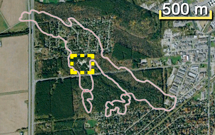Did you know that there’s a 10,000 year old sand dune hiding in a pine forest in suburban Ottawa?
Neat, right?
 The sand dune in the Pinhey Forest is an ancient remnant of the last ice age, when what we now know as Ottawa was submerged under the great Champlain Sea. Even 100 years ago, the dune system was up to 10 times larger than it is today, stretching from Woodroffe across Slack to Merivale Road, but suburban homes, businesses and well-intentioned tree planting by the National Capital Commission in the 1950s have reduced it to a fraction of its former size. This graphic from the Biodiversity Conservancy shows the dune size as shown in 1925 aerial images outlined against the current dune inside the yellow dotted line.
The sand dune in the Pinhey Forest is an ancient remnant of the last ice age, when what we now know as Ottawa was submerged under the great Champlain Sea. Even 100 years ago, the dune system was up to 10 times larger than it is today, stretching from Woodroffe across Slack to Merivale Road, but suburban homes, businesses and well-intentioned tree planting by the National Capital Commission in the 1950s have reduced it to a fraction of its former size. This graphic from the Biodiversity Conservancy shows the dune size as shown in 1925 aerial images outlined against the current dune inside the yellow dotted line.
I have been hearing about the sand dune hidden in a pine forest in the Greenbelt for years. Finally, one day toward the end of summer, two of the three boys and I set off on a little adventure to check it out.
I’ve driven down Slack Road countless times, and had no clue about the unique and fascinating ecosystem hiding behind behind the pine trees, but it’s certainly accessible when you set out to look for it. Park on the street near the mailboxes on Pineland Ave near Vaan Drive and you’ll see the entrance to the dunes. It’s truly hidden in plain sight.
Parts of the dunes are roped off, but there is plenty of room to walk around and explore. When the boys noticed some of the posts had been knocked down, they stopped to prop them back up again.
We poked around the edges of the dunes, noting the towering pines in one area, and the oak and maples flourishing in another. Be careful, we noticed a few places where poison ivy was also flourishing. You can see how leaves and pine needles would fall and decompose, creating a mulch that would allow plants that wouldn’t ordinarily thrive in sand to take hold and encroach on the dunes.
Not only is the dune an interesting geological artifact, but it’s home to plants and insects that don’t live anywhere else in the city. Conservationists are working to protect the dunes against the constant encroachment of native and invasive plant species. We originally thought these tables were part of an archaeological dig, but on reflection I’m betting they are used to filter the sand of other bio material.
Like most National Capital Commission trails, you’ll find a few picnic tables and even a washroom on the site. Exploring the dunes was a quick excursion – I’d be surprised if we were there more than an hour, even with a bit of poking around the walking paths through the surrounding forests. It made for an interesting set of conversations about the geological history of Ottawa, though, and about how people and nature leave their footprints on ecosystems. The boys were intrigued by the idea of a desert hiding in plain sight in a neighbourhood we drive past regularly.
There’s more information about efforts to preserve the dunes and some of the unique plants and insects on the Biodiversity Conservancy website. It would be interesting to go back in the heart of winter to see the dunes in various seasons.
Did you know about the secret sand dunes hiding in the Greenbelt? Have you visited? What did you think?










i had no idea! thank you for sharing your visit!
Very cool! I drive by the dune EVERY single work day and had no idea it was there…..
I used to drive past every day for work too! Makes me wonder what else I’ve been missing.
I had no idea Ottawa has sand dunes.
I’m going to check it out.
Thanks for sharing.